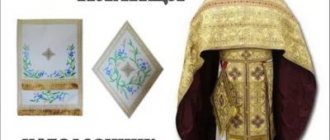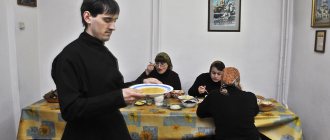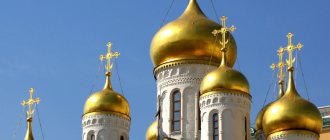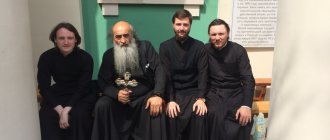"three types of monastic situation."
First situation
- This is an already established old monastery. This is what is usually meant by the words “becoming a monk.” Becoming a monk means for many people entering a monastery. And Father Seraphim writes that spiritual fruit in such a monastery is achieved through the suffering associated with staying in such a place, as well as through continuous connection with the past. Such a monastery, as it were, pulls a thread from the past, people join it, and as a result of this they get spiritual fruit, plus the suffering associated with staying in such a monastery.
Here Father Seraphim speaks about monasteries in the tradition of the Church Abroad. In August of this year, just a month ago, Abbess Alexandra from ROCOR(A) gave a report on the monasteries of the Church Abroad. She visited all the historical monasteries of the ROCOR. She describes four convents of the Church Abroad and the main monastery of the ROCOR, Jordanville. Her report carefully examines the routine of life and worship in such monasteries, but nowhere in the entire report is it mentioned, even briefly, the main activity of a monk - the Jesus Prayer. Maybe she has her own opinion, of course, but I also heard from other eyewitnesses who visited these monasteries that the main efforts there are aimed at receiving pilgrims and maintaining ancient buildings. Usually these monasteries have quite large real estate, which is difficult to maintain; the monks work for this, and I have never heard of the Jesus Prayer in the monasteries of the Church Abroad.
Although there is a slightly different monastery, different in spirit, it is located in Boston. In the USA there are even several such monasteries in the Church that is friendly to us, where they have a completely different attitude towards the Jesus Prayer, but they are all English-speaking, in a slightly different, Greek, tradition, but such monasteries do exist.
The second type of "monastic situation"
about which Father Seraphim writes, arises when a person begins to strive himself, according to his understanding of the examples of the great ascetics of the past. Father Seraphim explains that this is the most dangerous of all the monastic paths open today. And it's clear why. Father Seraphim gives many reasons why this is dangerous, and explains what qualities a person must have - an almost impossible combination of qualities - in order to survive like this. And, besides, such a hermitage in Russia is also a physically dangerous path. If in America, where Father Seraphim lived, you can fence off the territory, write “private territory”, and it will be quite well guarded, then in Russia all this is much more dangerous.
But there is one more thing that did not exist in the time of Father Seraphim, which is both good and evil. These are modern means of communication. If such an ascetic really tries not to use the Internet, then he chooses the second type described by Father Seraphim with all its dangers. If he uses the Internet, then he approaches the third type, because he has some like-minded people with whom he can communicate, and then he gets what Father Seraphim called the third type of “monastic situation.”
The third type of “monastic situation”
occurs when a group of several people begins to struggle, supporting each other. This case is very common for true Orthodoxy in Russia. There are parishes here, they are either apartment-type or churches (but the TOC managed to retain quite a few churches), in these communities there are people trying to live monastically, they usually stick together, and later one of them receives tonsure. Thus, at the parish, a small monastic community is obtained, usually of an urban type, which is often called monasticism in the world.
There are many problems here, but four lie on the surface. The first is how to keep in shape, the second is how to maintain some isolation from the world, the third problem of female monasticism is how to deal with lust (this is the other side of the problem of obedience), and the fourth problem is collective pride.
Celebrating the life of Saint Anthony
Bishop Athanasius lived in Alexandria in the 4th century. He described the life of Saint Anthony, a hermit living in the desert. He also wrote about the amazing struggle of hermits with demons, considering this an example of the perfection of a Christian. The life of this Saint has had a great influence on the numerous readers of this work. Saint Anthony was the first great monk, and the writings of Athanasius were the first evidence of praise for the emerging tradition of monasticism.
The first cenobite (communal) monastery was created by the former Roman soldier Pachomius in the 4th century. He managed to unite the monks under one roof with one abbot (father). He became the founder of the first true monastery in 323.
This monastery appeared in Tabennisi near Thebes in Egypt. About 40 monks began to live there in each house. Each such monastic family had its own abbot. Pachomius became the creator of monastic administration. It served as regulation of external monastic life, and not as spiritual guidance. At the end of the 4th century, Christian monasticism began to develop in other areas outside of Egypt.
1) How to keep fit
What is this problem? At first, and even for a long time, for several years, a person who tries to live like a monk retains some understanding of why this is necessary. A person tries to strive, and then over time, some adaptation to such a life develops, efforts begin to weaken, life enters into some kind of its own channel, and the initial understanding begins to be erased and clogged with vanity.
This is where it is very important to keep in shape. For this, five basic activities of a monk and every Christian are important. It is important to learn these activities before tonsure, so that they become habitual and so that they create a form.
What are these activities that keep you going like this? I will list them in random order.
a) Psalmody
Psalmody is worship. And here it is very important for monastics to get used to daily worship even before tonsure. At least to the minimum. It can be performed at home, it can be performed without a priest (a priest is not even needed at such monastic services). This is some part of the services of the daily circle, minimally it is Vespers. This is a certain backbone that simply must be there, without which everything will be washed away.
b) Reading
Daily reading of the Holy Fathers. Reading may be very small, but attentive. Firstly, these are ascetic readings, about how to change oneself, because it seems to a person that he knows exactly what he needs to do in order to change, but the holy fathers find how to do it better. And another reading is reading that helps many, this is reading some living books about Orthodoxy, which remind us why all this is needed, some lives, but not verified, but written “hot on the heels”, where they describe and pros, cons, and mistakes, which tells how people who tried to strive actually lived. So we just find ourselves in good company. Because when a person lives in the world, he inevitably communicates with people, and with good people, but they have a slightly different structure. And when we see the life of holy people who labored and tried before, they become some of our company with which we communicate.
c) Reflection
Thinking, first of all, about your sins. There is one very good trick here. It is difficult to force yourself to do this, because our inner person will not want to do it, but if you get used to it, it is a very good habit. Once a day, or better yet, twice a day, carry out a mechanical “inventory” of sins for a day or half a day: what bad things did I do during this time, this, this and this. And think about how I could, the next time I find myself in this situation, not step on this rake.
Here, of course, it is better not to think for yourself (and this is a very important point), you cannot trust your own ideas about your mistakes, but you need to consult with someone. When there is a good and experienced priest, it is good, but it is not at all necessary that it be a priest. It is enough that there is a like-minded person with whom this could be discussed and who can suggest something from the outside. Sometimes you can see from the outside what is not visible from the inside. I myself have nothing, but my neighbor can always see not only what he has, but also how he can improve! But it is actually useful to discuss everything. Here, of course, the thought arises that I myself know, but if I myself know, and this does not help, then it means that I know something wrong.
d) The fourth lesson is what is called prayer
This is the same Jesus Prayer, some special rule associated with the Jesus Prayer. This is a completely separate topic. But how does it help? Unlike the three previous activities, which create a kind of skeleton, it creates the joy for which all this can be done. As one contemporary figure in the Jesus Prayer said, our day is like smoked glass, and the monastic rule, the Jesus Prayer, is like a small window rubbed in this glass through which light is visible.
e) Handicrafts
This is work. Its main purpose is to prevent thoughts from wandering, it is such an anchor for the mind, but it is also needed in order to live by one’s own labor. Because monastics often have a special kind of temptation: the world begins to help the monks a lot, completely undeservedly. All sorts of sponsors appear, and then the temptation arises to live at the expense of sponsors, to somehow rely on them, to somehow communicate with them. But this is a big trap, it greatly corrupts a person. Of course, it is better, like the Apostle Paul, who made his own tents, to work and earn a living himself. And this is in the catacomb traditions: the catacomb monks did not disdain to work in secular jobs. But organizing your own business for a monastery or for a small monastic community, even in the world - doing and selling something - is very troublesome, and even unsafe in Russia. And it’s easier when people, having some skills, just quietly work in their fields in secular jobs.
This is about how to keep fit.
3) How to deal with covetousness,
with a desire to command. There is a very big problem with female monasticism. These nuns often find themselves involved in parish or diocesan activities, or in general church activities. Here it is very difficult to resist not to start bossing, especially if you are the boss by position (even more so, you need to restrain yourself more), and there may be several techniques here.
One very good rule to remember can be formulated as “keep your head down.” And you just need to remember about the very danger of giving orders. And it’s a joy to meet cases that allow you to humble yourself a little. To rejoice at every such unpleasant occasion, and these include the need for some kind of work, and harassment from the authorities. And, again, here you need to develop for yourself some kind of scheme on how to put the right barriers to your desire to command. It is advisable to develop it not on your own, but in consultation with someone who sees it from the outside.
4) The next danger is collective pride
This is not only among monastics, but in general it is a very dangerous thing for the TOC. I myself am a sinner, but what a good organization I belong to!.. Father Seraphim writes separately about collective pride precisely in relation to that group of people who organized their monastic community virtually from scratch. He says that "the appearance of being 'right' can produce spiritual complacency and disdain for those who, not being members of their group, are not so 'right'."
Father Seraphim gives advice on how to deal with this. He writes: “The less such a group is in the public spotlight, and the less it focuses on its “rightness” and its differences from older institutions, the better chance it has of maintaining its spiritual health.” That is, such a group should be in the center of public attention as little as possible.
Here we smoothly moved on to the side, but burning issue of female monasticism, to the problem of appearance,
Life of secret monks
All members of monastic communities went to work or studied. Spiritual mentors taught to treat work or study as obedience, to do it conscientiously, as for God. Everyone wore simple clothes; robes and hoods were worn only when being tonsured. The nuns didn’t even wear black scarves, so as not to attract attention. During Communion in churches the worldly name was called. They did not tell anyone about the tonsure, not even relatives. Sometimes only after the death of a secret monk, relatives found a note with the monastic name. But more often the secret of tonsure was known only to God.
To avoid persecution by the authorities, even those rare monks who had obediences under the church had to have a civilian job. At the same time, work was selected in such a way that it would not harm prayer and inner life.
The authorities tirelessly persecuted secret monastic societies; most monks and, especially, priests, experienced more than one imprisonment and exile. Secret monks took great risks. Most of them were repressed, many were shot. The soldiers of Christ, who achieved the feat of monasticism during the years of persecution, were ready to die for the sake of Christ. Their life became a sermon for those around them. They preserved the life of the Church, adorned it with a host of new martyrs, confessors, and holy martyrs.
Council of New Martyrs and Confessors of Russia,
may we, sinful servants of Christ, also have mercy through their holy prayers.
Amen. Secret monasticism
Clothes problem
I am talking here not about those who live in monasteries, but about those who live in the world. There are two approaches here. Some people think that you should always wear a cassock, while others think that it is not necessary.
Anyone who has walked down the street in a cassock knows that this is a very strong attraction for attention, two types of attention. The first is drunkards who immediately have a great religious impulse; when drunk, they have a need to communicate on religious topics. And the second is, again, undeserved very good attention from people. Sometimes, on the contrary, it is aggression, but more often it is some kind of signs of attention: they give up a place, let them skip the line. Is it necessary?
I studied the arguments in favor of wearing a cassock on the street. There are several arguments.
a) first argument,
which is most often encountered, was formulated by one of those present here as follows: “If you call yourself a milk mushroom, get into the back.” Yes, a monk takes certain vows when taking vows, but among them there is no vow to wear medieval everyday oriental clothing. Because the cassock and apostle are common clothes in the East, they have been preserved there as everyday clothing to this day.
But how important is it to walk in oriental medieval clothing on the streets? In the service there is a ceremony and ritual, but in everyday life?
b) second argument:
One Greek priest in America told me, emphasizing why it is important to walk in a cassock, how he stood somewhere on the street, and young people stood nearby, they did not see him and used some swear words. Then they saw him, apologized and began to speak good English. And so, this is an argument in favor of the cassock. In fact, Orthodoxy does not have the goal of teaching people to express themselves this way and not that, and anyone who has tried to teach young people not to use obscene language knows how much violence it really is against them, how serious coercion it is for them. But is it necessary to use the cassock to transform Orthodoxy into some kind of system of restrictions and coercion?
c) another reason:
I preach Christianity when I walk around in a cassock. It seems to me that this is not a healthy reason at all. If a person seriously thinks that he is preaching Christianity with his appearance, then this is a reason to hit himself on the forehead and somehow treat himself more soberly.
Monasticism spreads to the West
Athanasius managed to transfer the monastic rule of Pachomius further to the West. This he did when he was exiled in 340 to Trier, a city in Germany. Athanasius was exiled because of his opposition to the imperial doctrines of Arianism. Another monk from Syria, Mar Avgin, took monasticism to Mesopotamia. And Jerome became the founder of a Christian monastery in Bethlehem.
Basil the Great became one of the three Cappadocian fathers in the 4th century. He finally shaped the monastic community life of the Byzantine Church. His ascetic works became the theological and educational basis for the "common life" called Cenobitism. Basil the Great created monastic rules, according to which, with some changes and modifications, they became the authority for subsequent Orthodox monasticism. Basil's rules preserve the Orthodox combination of asceticism and mysticism in our century.










